Abstract
Home area networks (HANs) are the most vulnerable part of smart grids since they are not directly controlled by utilities. Device authentication is one of most important mechanisms to protect the security of smart grid-enabled HANs (SG-HANs). In this paper, we propose a situation-aware scheme for efficient device authentication in SG-HANs. The proposed scheme utilizes the security risk information assessed by the smart home system with a situational awareness feature. A suitable authentication protocol with adequate security protection and computational and communication complexity is then selected based on the assessed security risk level. A protocol design of the proposed scheme considering two security risk levels is presented in the paper. The security of the design is verified by using both formal verification and informal security analysis. Our performance analysis demonstrates that the proposed scheme is efficient in terms of computational and communication costs.
1. Introduction
Smart grids offer many valuable benefits compared with traditional power grids. By enabling distributed power generation, distributed power storage, and microgrids in smart grids, more efficient and reliable power supply can be achieved [1]. The power generation of smart grids uses a mix of traditional fuel based power sources and renewable power sources such as wind farm and solar plant, which can significantly reduce the carbon footprint. The study in [2] shows that by 2030, emissions can be reduced by 5% when adopting conservative approach to smart grids. The reduction can be nearly 16% if aggressive approach is adopted. The connection of home area networks (HANs) to smart grids enables the automation of home energy use. Smart grids also provide important infrastructure support for increased using of electric vehicles (EVs) through vehicle-to-grid (V2G) networks [3].
On the other hand, the implementation of smart grids faces major challenges in both physical and cyber domains. Since smart grids contain millions of nodes along with a complex control system, how to achieve the collaboration between components and the large-scale deployment of new devices and technologies becomes a crucial challenge [1]. Connecting power grids to cyber networks for advanced monitoring and control exposes the grids to cyber-attacks which can result in catastrophic damages as demonstrated by the 2015 Ukrine Blackout [4].
In this work, we concentrate on the security of smart grid-enabled HANs (SG-HANs), which connects many smart devices (SDs) of a smart home such as smart appliances, renewable energy sources and storage, EVs, etc. to smart grids. HANs are the most vulnerable part of smart grids since utilities have no direct control of this part [5]. Device authentication is one of the most important mechanisms to protect the security of SG-HANs against various attacks. In addition to the security consideration, the device authentication protocol must be lightweight since many of the SDs have limited computation power and memory storage. To this end, we propose a situation-aware scheme for efficient device authentication in SG-HANs. Unlike existing work, the proposed scheme selects a suitable authentication protocol based on the security risk information assessed by the smart home system. The aim of the scheme is to provide adequate security protection with reduced computational complexity, communication cost and power consumption. To the best of our knowledge, the proposed scheme is the first work that utilizes the situational awareness feature of smart home system for efficient device authentication in HANs.
The rest of this paper is organized as follows. Related work on device authentication in SG-HANs, situational awareness of smart home and situation-aware security schemes is described in Section 2. The system architecture of SG-HANs and the adopted attack model are introduced in Section 3. Section 4 presents the proposed situation-aware device authentication scheme for SG-HANs. The security analysis and performance analysis of the proposed scheme are provided in Section 5 and Section 6, respectively. Finally, conclusions are drawn in Section 7.
2. Related Work
2.1. Device Authentication in SG-HANs
There are a number of works in the literature on device authentication in SG-HANs. Li proposed a ECC (Elliptic Curve Cryptography) based authenticated key establishment (EAKE) protocol for smart home energy management system in [6]. The EAKE protocol has two phases: a device or a security manager receives private/public key pair from the Certificate Agent (CA) through an out-of-band channel in the first phase; the initial session key is then established between the device and the security manager using the EAKE protocol in the second phase. In Ref. [7], Vaidya et al. also proposed a device authentication protocol for smart energy home area networks based on ECC. Both protocols of [6,7] are expensive for resource-limited devices due to the use of public key cryptography.
In Ref. [8], a secure key agreement protocol was proposed for radio frequency for consumer electronics (RF4CE) ubiquitous smart home systems based on symmetric key cryptography. In the proposed protocol, the initial unique secure information is pre-shared between the devices and manufacturers. The RF4CE-based controller receives the secret information from the manufacturer to authenticate a new device.
Ayday and Rajagopal [5] proposed three different device authentication mechanisms for the SG-HANs that provide (1) authentication between the gateway and the smart meter, (2) authentication between the smart appliances and the HAN, and (3) authentication between the transient devices and the HAN. The design of the three authentication mechanisms is based on symmetric key cryptography with the help of the trust center through the Internet.
Kumar et al. [9] proposed a lightweight and secure scheme for establishing session-key in smart home environments based on symmetric key cryptography. The smart home devices register with the security service provider offline to obtain security parameters including identity, a secret key with key identifier and a short authentication token. They also proposed a secure authentication and key agreement framework for smart home environments in [10] which realizes anonymity and unlinkability. The protocol is lightweight in comparison to other schemes because the design uses less encryption and decryption operations, and the number of exchanged messages is small.
Gaba et al. [11] proposed a robust and lightweight mutual authentication scheme called RLMA for distributed smart environments such as smart homes and smart buildings. The scheme utilizes implicit certificates to achieve simple and efficient mutual authentication and key agreement between smart devices in a smart environment.
2.2. Situational Awareness of Smart Home
Situational awareness is one of the essential features for smart homes [12]. The majority of the existing works for the situational awareness of smart homes are on activity recognition. For example, Wan et al. [13] proposed a dynamic sensor stream segmentation technology which helps the smart home system to categorize multiple sensor streams that belong to the same activity. Sensor correlation calculation and time correlation calculation are applied for the task. In Ref. [14], a data-driven approach based on neural network ensembles was developed for human activity recognition in smart home environments. Various approaches were explored to resolve conflicts between base models used in ensembles. Cicirelli et al. [15] proposed a framework for activity recognition under the cloud-assisted agent-based smart home environment (CASE). By using cloud computing technology, a smart home system can have greater analytic power. The work introduces an innovate approach, which embed activity recognition tasks including data acquisition, feature extraction, activity discovery, and activity recognition into different layers of CASE.
There are only a few works on the situational awareness of the smart home in cyberspace. A framework to measure the security risk of information leakage in IoT-based smart homes was proposed by Park et al. in [16]. The risk assessment is performed using the factor analysis of information risk (FAIR) method. The risk level for cyber situational awareness is obtained through risk grade clustering based on security scenarios.
2.3. Situation-Aware Security Schemes
There are a few recent works on developing situation-aware security schemes. Kim et al. [17] proposed DAoT, a dynamic and energy-aware authentication scheme for IoT devices. The scheme selects different key establishment (KE), message authentication code (MAC) and handshake operations to achieve energy efficient device authentication. The work evaluated the energy costs of different KE, MAC and handshake operations.
In Ref. [18], Hjelm and Truedsson investigated situation-aware adaptive cryptography for an IP camera. Situation parameters from WiFi and Bluetooth connections of the IP camera are used to determine the protection level. The cryptographic algorithms for encryption, hash and message authentication are then selected that are most suitable for the protection level. The power consumption, computational time and communication throughput were examined for different cryptographic algorithms.
Gebrie and Abie [19] proposed a risk-based authentication scheme for health care-related IoT authentication in smart homes. The channel characteristics in wireless body area network (WBAN) including Received signal strength indicator (RSSI), channel gain, temporal link signature, and Doppler measurement are used to determine risk level by using a naive Bayes algorithm. The authentication decision is then performed based on the risk level. For example, timeout and re-authentication will be performed if the risk level is determined as abnormal. It should be noted that there are no actual protocols designed in [17,18,19].
3. System Architecture and Attack Model
In this section, we introduce the system architecture of SG-HANs and the adopted attack model.
3.1. System Architecture of SG-HANs
The system architecture of SG-HANs considered in our work is shown in Figure 1, which consists of the infrastructure part and the HAN part. The infrastructure part controlled by utilities consists of smart meters (SMs), neighborhood area network (NAN) gateways, and control center. The HAN part in each house is controlled by the home owner, which consists of a number of SDs and one HAN gateway (HGW). A SD communicates with the HGW using a wireless protocol such as ZigBee or MQTT. In this work, we are interested in the authentication between SDs and HGW in the HAN part, which is helped by the control center. We assume that the smart home system is installed in the HAN with a situational awareness feature. Although the design of situational awareness feature is out of the scope of this work, we envision that the security risk assessment of the smart home system should combine activity recognition in physical domain [13,14,15] and risk analysis in cyber domain [16].

Figure 1.
System architecture of SG-HANs.
3.2. Attack Model
The attack model considered in this work is the Dolev–Yao model [20]. In the model, the attacker can eavesdrop, intercept, inject, replay and modify messages exchanged on the open channel. Accordingly the attacker can launch various types of attacks including man-in-the-middle (MITM) attacks, replay attacks and impersonation attacks. Under this attack model, the proposed scheme will achieve security goals of message integrity, mutual authentication and session key establishment, and resistance against various attacks.
4. Proposed Scheme
In this section, we present a protocol design of the proposed situation-aware device authentication scheme for SG-HANs. Without loss of generality, we assume that the security risk assessed by the smart home system has two levels, low and high. The design can be easily extended to more than two security risk levels. The proposed scheme consists of two phases: device registration phase and device authentication and key agreement phase. Table 1 lists the notations and their descriptions that are used in the paper.

Table 1.
Notations and their descriptions used in this paper.
We have made the following assumptions for the proposed scheme: (1) SD has a clock which runs on its own battery and its assumed to be syAyday2013nchronized with the HGW’s clock. (2) HGW is assumed to be authenticated before SD-HGW authentication takes place.
4.1. Device Registration Phase
Before installed in a SG-HAN, each SD needs to be registered offline at the control center. During the registration, the control center assigns an identification number to the registered SD A along with a random number . Furthermore, the control center computes secret . Finally, the control center sends and to the SD A, and and to the HGW. The device registration phase is illustrated in Figure 2.
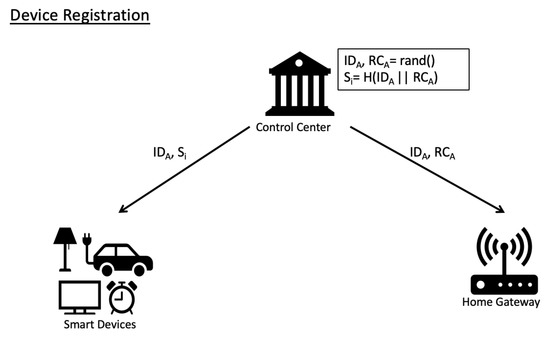
Figure 2.
Illustration of device registration phase.
4.2. Device Authentication and Key Agreement Phase
After the registration, the SD A starts the authentication and key agreement process by sending the message to the HGW. includes an message header and as shown below:
Upon receiving , the HGW obtains the current security risk level from the smart home system. The following messages between the SD A and the HGW are generated based on the security risk level.
(a) Low security risk
When the security risk is low, the HGW computes and extracts current time stamp . Then the HGW computes and . is the header of the message that the HGW sends to the SD A.
Upon receiving the message at time stamp , the device A knows from the message header that the current security risk level is low. The ID of the HGW and can be obtained by computing . The device A also computes . Then the SD A will check if and , where is the transmission delay. If not, the authentication process will be aborted. Otherwise, the SD A generates the secret and extracts the current time stamp . Then the SD A computes and , where is the header of the message . Finally, the SD A sends to the HGW:
The SD A computes the key which will be used as the shared session key between the device and the HGW.
When the HGW receives at time stamp , it first computes and then extracts and by computing . The HGW checks if and , where . Assume all checks pass, the HGW adds to the trusted list of devices and computes the key . After this step, both the SD A and the HGW have generated the symmetric session key which will be used for future data communication.
(b) High security risk
When the security risk level obtained by the HGW is high, the message exchange between the SD A and the HGW needs higher security strength.
Upon receiving under high security risk, the HGW computes and generates a random number . Then the HGW extracts current time stamp and forms as following:
where is the message header of , and . Finally, the HGW sends to the SD A.
Upon receiving the message at time stamp , the SD A learns from the message header that the security risk level is high. The SD A then uses to decrypt to obtain , and . Then it checks if and , where . The authentication process will be terminated if the check is failed. Otherwise, the SD A generates the secret and a random number . Then the device extracts the current time stamp and computes and , where = ‘SD-HIGH’ is the message header of . The message is then formed and sent to the HGW:
Finally, the SD A computes the shared key as .
After receiving at time stamp , the HGW computes the secret and extract , and by performing . The HGW then computes and checks if and . If all checks pass, the HGW adds to the trusted list of devices and computes the session key .
Figure 3 and Figure 4 show the message flows of the proposed scheme under low security risk and high security risk, which are denoted as two protocols and , respectively.
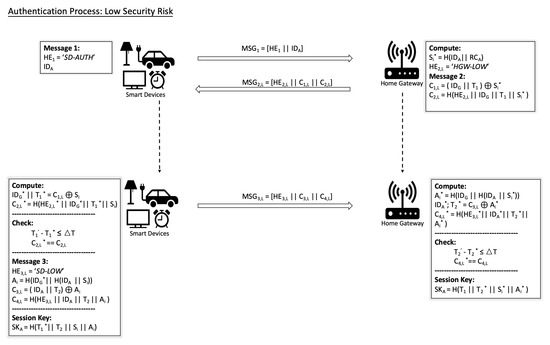
Figure 3.
The message flow of the proposed scheme at low security risk ().
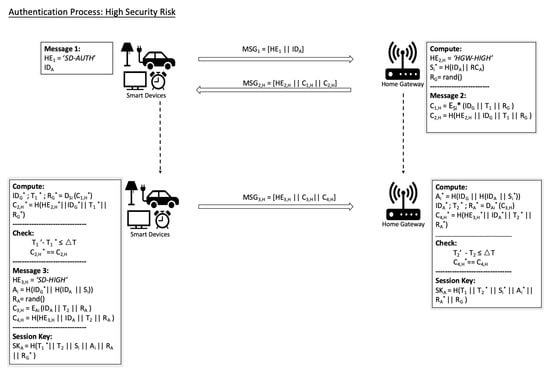
Figure 4.
The message flow of the proposed scheme at high security risk ().
5. Security Analysis
In this section, we verify the security of the proposed scheme using formal verification and informal security analysis.
5.1. Formal Security Verification
The formal security verification of the proposed scheme was done by using the automated validation feature of the Internet Security Protocols and Applications (AVISPA) tool [21], which is a push-button security analyzer tool designed for large scale internet security-sensitive protocols. AVISPA tool has been widely applied for formal security analysis of authentication protocols [9,10,22,23,24].
The architecture of AVISPA tool is illustrated in Figure 5. High Level Protocol Specification Language (HLPSL) is used to describe protocol design and specify security goals. AVISPA tool takes a HLPSL file as input and translates the file into intermediate format (IF) by using HLPSL2IF translator. The IF code becomes the input to the backend, where protocol security goals will be verified. Finally, the backend outputs the security report. As shown in Figure 5, the backend of AVISPA tool consists of four components: on-the-fly Model-Checker (OFMC), CL-based Attack Sercher (CL-AtSe), SAT-based Model-Check (SATMC), and Tree Automata-based Protocol Analyzer (TA4SP). Users can choose the backend components according to security requirements of their design. Notice that HLPSL is a role based language. The basic role states initial variables, constants, and transition steps. The composed role instantiate one or more basic roles. Finally, a top level role called environment role, states global constants and a composition of multiple sessions.
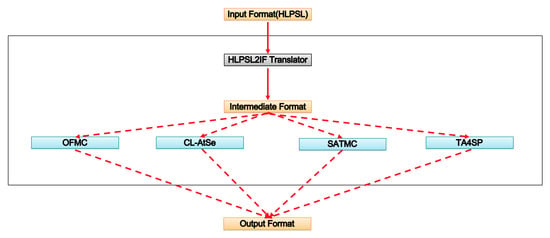
Figure 5.
Architecture of the AVISPA tool [21].
The security goals of the proposed scheme are specified in Figure 6 as: (1) secrecy_of sessionkey means that the session key generated in the proposed scheme is kept secret between the SD and the HGW; (2) authentication_on gateway_Si means that secret will be verified at the SD; (3) authentication_on_device_Ai means that secret will be verified at the HGW; (4) authentication_on_device_t2 means that the timestamp generated by the SD will be agreed between the SD and the HGW; (5) Similarly, authentication_on_gateway_t1 verifies the agreement on timestamp between the HGW and the SD. The first security goal tests the strength and secrecy of the session key against various attacks such as MITM attack. The second and third security goals together confirm the establishment of mutual authentication, and the last two security goals test the protocol design against replay attacks. By running the HLPSL file through the backend, we test not only the protocol design against various attacks, but also whether the protocol satisfies specific requirements.

Figure 6.
Specification of security goals of the proposed scheme.
Figure 7 and Figure 8 specify the roles of the SD and the HGW for low security risk, respectively. In the SD role, State 0 indicates the beginning of the authentication process. At State 0, the SD starts the authentication process by sending identity to the HGW through the function. On the other side, the HGW receives the device identity at State 0 by using the function. Upon receiving , the HGW will move to State 1, where secret is generated by using the built-in hash function , will be generated as random number by calling function. Then the HGW uses built-in function to generate the response message. Similarly, after sending to the HGW, the SD will move to State 1 and wait for the response message from the HGW. Both SD and HGW generates the session key at State 2. Similar to low security risk, Figure 9 and Figure 10 specify the SD and HGW roles for high security risk, respectively.
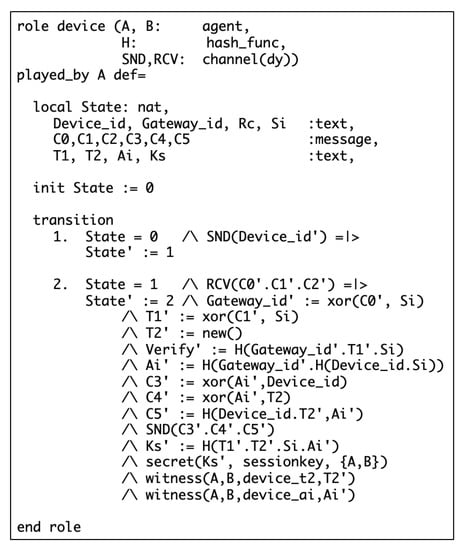
Figure 7.
Specification of the SD role for low security risk.
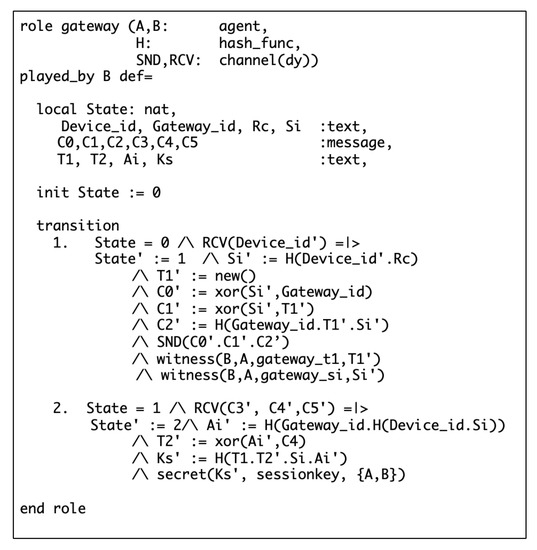
Figure 8.
Specification of the HGW role for low security risk.
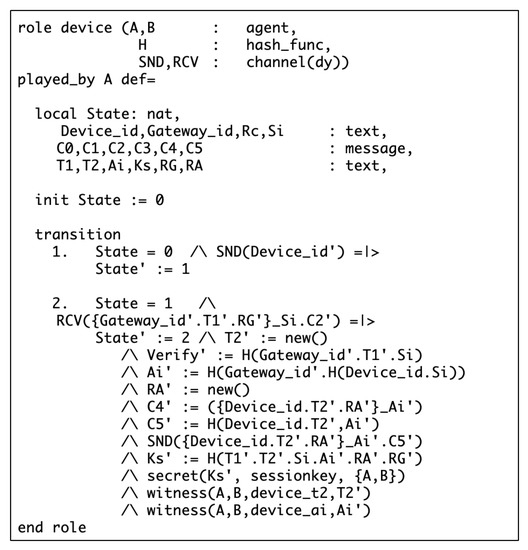
Figure 9.
Specification of the SD role for high security risk.
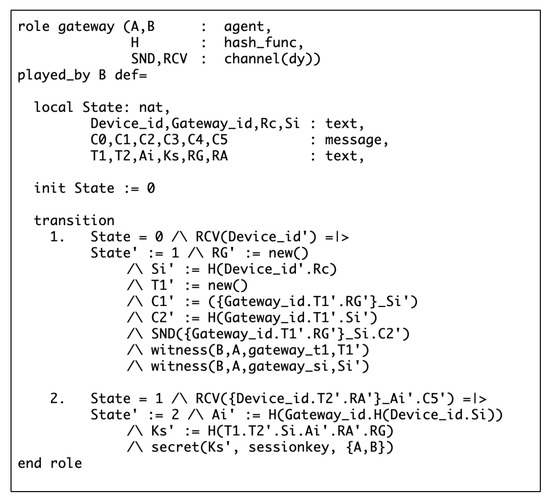
Figure 10.
Specification of the HGW role for high security risk.
Figure 11 specifies the protocol session role. In this role, we instantiate one instance of each basic role and compose them together to construct the whole protocol session. Channel(dy) declaration means that the intruder has full control over the channel, where dy stands for the Dolev–Yao attack model. Finally, the top-level environment role is defined in Figure 12. This role defines device ID, gateway ID, and as global constants, and a composition of three sessions. Note that the intruder represented as constant i, will have names of all agents as initial knowledge.
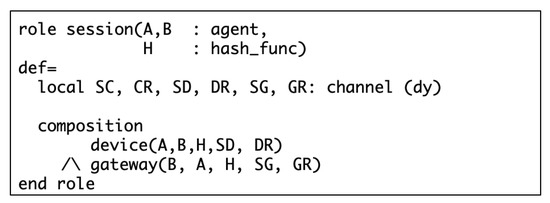
Figure 11.
Specification of the session role.
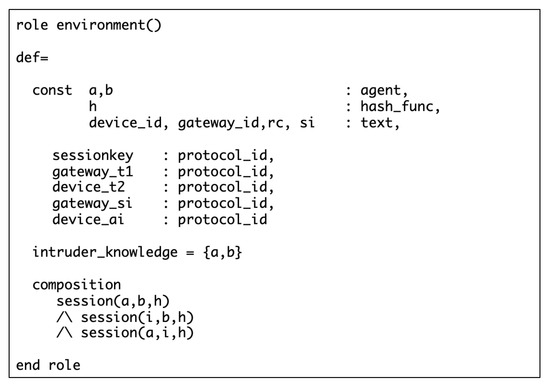
Figure 12.
Specification of the environment role.
The outputs of the OFMC and CL-AtSe backends for and of the proposed scheme are shown in Figure 13, Figure 14, Figure 15 and Figure 16. The results show that the proposed scheme is safe in the OFMC and CL-AtSe backends. This means that the proposed scheme successfully meets specified security goals.
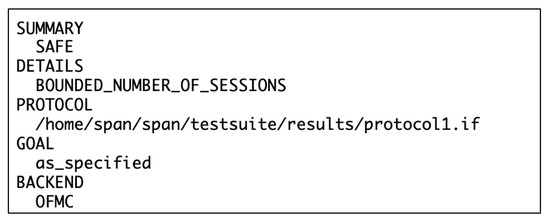
Figure 13.
Output of OFMC backend for low security risk.
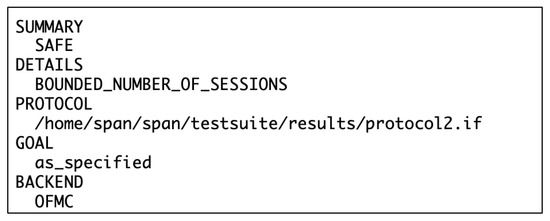
Figure 14.
Output of OFMC backend forhigh security risk.
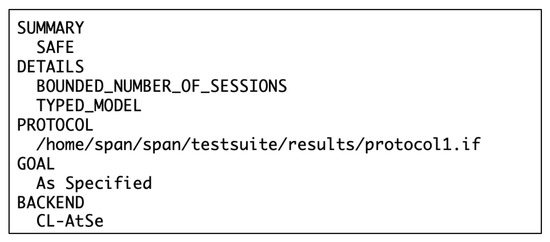
Figure 15.
Output of CL-AtSe backend for low security risk.
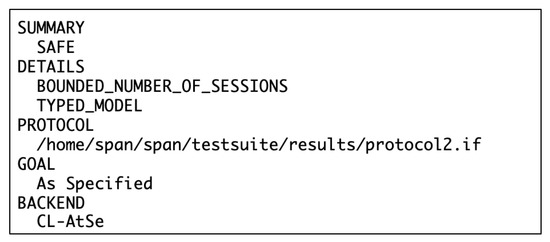
Figure 16.
Output of CL-AtSe backend for high security risk.
5.2. Informal Security Analysis
In this section, we perform an informal security analysis to show how the proposed scheme achieves different security objectives.
5.2.1. Message Integrity
Both and of the proposed scheme use one-way hash functions to achieve the message integrity. To tamper the transmitted messages, the attacker needs to learn the secrets and which can not be obtained through the eavesdropped messages. Thus, the attacker cannot compute a valid hash value for a message, which means that the proposed scheme achieves the message integrity properly.
5.2.2. Mutual Authentication
Mutual authentication is an important property to verify the legitimacy of the SD and HGW to each other. In the proposed scheme, the SD authenticates the HGW by verifying the validity of the value using the secret . The HGW then authenticates the SD by verifying the validity of the value using the secret . As the secrets and cannot be obtained from the eavesdropped messages, the proposed scheme support the mutual authentication between the SD and HGW.
5.2.3. Resistance against MITM Attack
An attacker can launch the MITM attack by relaying and manipulating the messages exchanged between the SD and HGW. In the proposed scheme, the attacker needs to learn the secret to manipulate the messages successfully. Since the secret cannot be obtained from the previously eavesdropped messages, the propose scheme can resist the MITM attack.
5.2.4. Resistance against Replay Attack
In the replay attack, the attacker can replay previously eavesdropped messages to establish an authenticated session with the targeted entity. The proposed scheme uses the timestamp to verify if a received message is valid or not. Since the replayed message has the old timestamp, it cannot pass the verification. Thus, the proposed scheme can resist the replay attack.
5.2.5. Resistance against Impersonation Attack
An attacker may impersonate a SD by forging the request message with a fake/stolen ID as is in plain text. However, the response message from the HGW cannot be interpreted by the attacker since the secret is unknown to the attacker. Therefore, the attacker cannot continue the authentication process. There is also no way for the attacker to impersonate the HGW by forging the response message since the HGW identity is protected with the secret during the transmission. Thus, the proposed scheme can resist the impersonation attack.
6. Performance Analysis
Since a SD is usually resource limited, the design of authentication scheme should not overwhelm the SD’s computational and communication resources. In this section, we perform an analysis of the computational and communication costs of the proposed scheme.
6.1. Communication Cost
The communication cost of the proposed scheme is evaluated using the total number of bits sent and received by the SD and the communication energy cost. In the analysis, we assume that message header is 3 bits in length, device ID and HGW ID are 8 bits, timestamp and random number are 32 bits, and outputs of hash and encryption operations are 128 bits.
Table 2 compare the proposed scheme with [6,8,9] in terms of total number of exchanged messages. Both and of the proposed scheme require three messages exchanged between the SD and the HGW, which is comparable to that of [9] and less than those of [6,8].

Table 2.
Comparison of total number of exchanged messages.
The communication overheads of and of the proposed scheme in terms of total number of bits are shown in Table 3, which are calculated using aforementioned parameters. Figure 17 shows the communication overhead of the proposed scheme with different percentages of and being used. Generally, the higher chance that is used, the lower the communication overhead of the proposed scheme. The communication overheads of three existing works [6,8,9] are also plotted in Figure 17. It is obvious that the proposed scheme achieves the lowest communication overhead even only is used.

Table 3.
Communication overhead (in bits).
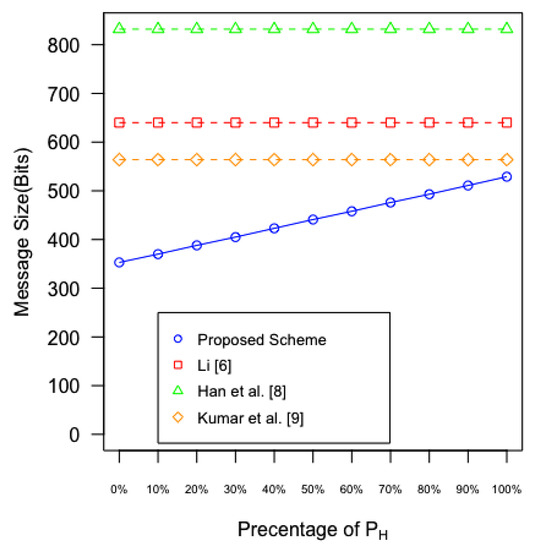
Figure 17.
Communication overhead of the proposed scheme compared with those of three existing works [6,8,9].
Besides communication overhead, communication energy cost is another important factor when evaluating communication cost. In order to simulate a resource limited SD, we used the TelosB platform which embeds a 16-bit processor running at 8 MHz clock frequency. TelosB also has limited amount of memory: 48 KB of ROM and 10 KB of RAM [25]. To measure the communication energy cost, we obtained the energy costs of sending and receiving one bit of data on TelosB platform as 0.72 and 0.81 from [26]. Then the communication energy costs of and are obtained as 269.55 and 403.47 (Table 4). Table 5 compares the communication energy cost of the proposed scheme with those of [6,8,9]. We assume that and have equal chance to be used for the proposed scheme. The results indicate that the proposed scheme is more efficient than other schemes in terms of communication energy cost.

Table 4.
Communication energy cost.

Table 5.
Comparison of communication energy cost.
6.2. Computational Cost
Table 6 compares the computational cost of the proposed scheme with those of [6,8,9]. In the table, ‘H’ represents the time to execute one hash function. ‘XOR’ represents the time to perform an exclusive-or operation. ‘E’ and ‘D’ represent the times to perform encryption and decryption, respectively. ‘MAC’ and ‘HMAC’ represent the times used to compute the message authentication code and the hashed message authentication code, respectively. ‘t’ is the time to perform a point multiplication operation. As shown in Table 6, of the proposed scheme requires five hash operations and two XOR operations while requires five hash operations, one encryption operation and one decryption operation. Since both and use five hash operations, a time and memory efficient hash algorithm such as BLAKE2 [27] is recommended for the proposed scheme. In comparison, the scheme proposed in [6] requires two point multiplication operations, one MAC operation, one encryption operation, one decryption operation, and one hash operation. Note that the point multiplication operation has high computational complexity compared with other operations. The scheme proposed in [8] requires seven MAC operations, four encryption operations, four decryption operations, and five hash operations. Finally, two hash operations, one MAC operation, one HMAC operation, one encryption operation and one decryption operation are required for the scheme of [9]. Overall, the proposed scheme is computational efficient and easy to implement compared with other schemes.

Table 6.
Comparison of computational costs.
We also analyzed the computational energy cost of the proposed scheme using a similar method of [9]. The energy consumption of a SD (E) is calculated by using the formula , where V is the voltage of the new batteries and I is the current of the circuit. Both V and I were retrieved from the TelosB datasheet [25]. The energy costs of executing hash function and encryption algorithm on TelosB platform can be computed based on the work of [28]. To compare with other schemes, we also obtained the energy costs of MAC and HMAC operations and point multiplication operation from [9,26], respectively. Since the time of executing XOR operation is negligible compared with other operations, it was excluded from the evaluation. The computational energy costs of different operations are shown in Table 7. Table 8 compares the total computational energy cost of the proposed scheme (50% and 50% ) with those of [6,8,9]. The results indicate that the proposed scheme is more efficient than other schemes in terms of computational energy cost.

Table 7.
Computational energy costs of different operations.

Table 8.
Comparison of computational energy costs.
7. Conclusions
Situation awareness is the essential feature of a smart home system which can be used to develop various smart applications. In this paper, we propose an efficient device authentication scheme for SG-HANs that can adapt to the security risk information assessed by the smart home system. The scheme selects a suitable authentication protocol based on the assessed security risk level that provides adequate security protection with reduced computational and communication costs. We presents a protocol design of the proposed scheme by considering two security risk levels. A formal security verification using AVISPA tool and an informal security analysis are performed to prove the security of the design. The performance analysis demonstrates that the proposed scheme is efficient for device authentication in SG-HANs in terms of both computational and communication costs. In future, we will research how to use the information collected by the smart home system in both physical and cyber domains to assess the security risk level, which is the key to enable the proposed scheme.
Author Contributions
Conceptualization, J.Z.; methodology, A.X. and J.Z.; formal analysis, A.X. and J.Z.; software, A.X.; writing–original draft preparation, A.X. and J.Z.; writing–review and editing, A.X. and J.Z.; supervision, J.Z.; funding acquisition, J.Z. All authors have read and agreed to the published version of the manuscript.
Funding
This material is based upon work funded by the National Science Foundation EPSCoR Cooperative Agreement OIA-1757207.
Conflicts of Interest
The authors declare no conflict of interest.
References
- Fang, X.; Misra, J.; Xue, G.; Yang, D. Smart grid—The new and improved power grid: A survey. IEEE Commun. Surv. Tutor. 2012, 14, 944–980. [Google Scholar] [CrossRef]
- Hledik, R. How green is the smart grid? Electr. J. 2009, 22, 29–41. [Google Scholar] [CrossRef]
- Shaukat, N.; Khan, B.; Ali, S.M.; Mehmood, C.A.; Khan, J.; Farid, U.; Majid, M.; Anwar, S.M.; Jawad, M.; Ullah, Z. A survey on electric vehicle transportation within smart grid system. Renew. Sustain. Energy Rev. 2018, 81, 1329–1349. [Google Scholar] [CrossRef]
- Liang, G.; Weller, S.; Zhao, J.; Luo, F.; Dong, Z. The 2015 Ukraine blackout: Implications for false data injection attacks. IEEE Trans. Power Syst. 2017, 32, 3317–3318. [Google Scholar] [CrossRef]
- Ayday, E.; Rajagopal, S. Secure Device Authentication Mechanisms for the Smart Grid-Enabled Home Area Networks; Technical Report; 2013; pp. 1–18. Available online: https://infoscience.epfl.ch/record/188373/files/smart_grid_tech_report.pdf (accessed on 20 May 2020).
- Li, Y. Design of a key establishment protocol for smart home energy management system. In Proceedings of the 2013 Fifth International Conference on Computational Intelligence, Communication Systems and Networks, Madrid, Spain, 5–7 June 2013; pp. 88–93. [Google Scholar]
- Vaidya, B.; Makrakis, D.; Mouftah, H.T. Device authentication mechanism for smart energy home area networks. In Proceedings of the 2011 IEEE International Conference on Consumer Electronics (ICCE), Las Vegas, NV, USA, 9–12 January 2011; pp. 787–788. [Google Scholar]
- Han, K.; Kim, J.; Shon, T.; Ko, D. A novel secure key pairing protocol for RF4CE ubiquitous smart home systems. Pers. Ubiquit. Comput. 2013, textit17, 945–949. [Google Scholar] [CrossRef]
- Kumar, P.; Gurtov, A.; Iinatti, J.; Ylianttila, M.; Sain, M. Lightweight and secure session-key establishment scheme in smart home environments. IEEE Sens. J. 2016, 16, 254–264. [Google Scholar] [CrossRef]
- Kumar, P.; Braeken, A.; Gurtov, A.; Iinatti, J.; Ha, P.H. Anonymous secure framework in connected smart home environments. IEEE Trans. Inf. Forensics Secur. 2017, 12, 968–979. [Google Scholar] [CrossRef]
- Gaba, G.S.; Kumar, G.; Monga, H.; Kim, T.-H.; Kumar, P. Robust and lightweight mutual authentication scheme in distributed smart environments. IEEE Access 2020, 8, 69722–69733. [Google Scholar] [CrossRef]
- Lee, S.-Y.; Lin, F.J. Situation awareness in a smart home environment. In Proceedings of the 2016 3rd World Forum on Internet of Things (WF-IoT), Reston, VA, USA, 12–14 December 2016; pp. 678–683. [Google Scholar]
- Wan, J.; O’grady, M.J.; O’hare, G.M. Dynamic sensor event segmentation for real-time activity recognition in a smart home context. Pers. Ubiquit. Comput. 2015, 19, 287–301. [Google Scholar] [CrossRef]
- Irvine, N.; Nugent, C.; Zhang, S.; Wang, H.; Ng, W.W.Y. Neural network ensembles for sensor-based human activity recognition within smart environments. Sensors 2020, 20, 216. [Google Scholar] [CrossRef] [PubMed]
- Cicirelli, F.; Fortino, G.; Giordano, A.; Guerrieri, A.; Spezzano, G.; Vinci, A. On the design of smart homes: A framework for activity recognition in home environment. J. Med. Syst. 2016, 40, 200. [Google Scholar] [CrossRef] [PubMed]
- Park, M.; Oh, H.; Lee, K. Security risk measurement for information leakage in IoT-Based smart homes from a situational awareness perspective. Sensors 2019, 19, 2148. [Google Scholar] [CrossRef] [PubMed]
- Kim, Y.; Yoo, S.; Yoo, C. DAoT: Dynamic and energy-aware authentication for smart home appliances in internet of things. In Proceedings of the 2015 IEEE International Conference on Consumer Electronics (ICCE), Las Vegas, NV, USA, 9–12 January 2015; pp. 196–197. [Google Scholar]
- Hjelm, V.; Truedsson, M. Situation-Aware Adaptive Cryptography. Master’s Thesis, Lund University, Lund, Sweden, 2018. [Google Scholar]
- Gebrie, M.T.; Abie, H. Risk-based adaptive authentication for internet of things in smart home ehealth. In Proceedings of the 11th European Conference on Software Architecture (ECSA), Canterbury, UK, 11–15 September 2017; pp. 102–108. [Google Scholar]
- Dolev, D.; Yao, A. On the security of public key protocols. IEEE Trans. Inf. Theory 1983, 29, 198–208. [Google Scholar] [CrossRef]
- Viganò, L. Automated security protocol analysis with the AVISPA tool. Electron. Notes Theor. Comput. Sci. 2006, 155, 61–86. [Google Scholar] [CrossRef]
- Chen, C.; He, D.; Chan, S.; Bu, J.; Gao, Y.; Fan, R. Lightweight and provably secure user authentication with anonymity for the global mobility network. Int. J. Commun. Syst. 2011, 24, 347–362. [Google Scholar] [CrossRef]
- Nicanfar, H.; Jokar, P.; Beznosov, K.; Leung, V. Efficient authentication and key management mechanisms for smart grid communications. IEEE Syst. J. 2014, 8, 629–640. [Google Scholar] [CrossRef]
- Mohammadali, A.; Haghighi, M.S.; Tadayon, M.H.; Nodooshan, A.M. A novel identity-based key establishment method for advanced metering infrastructure in smart grid. IEEE Trans. Smart Grid 2018, 9, 2834–2842. [Google Scholar] [CrossRef]
- TelosB Datasheet. Available online: http://www.memsic.com/userfiles/files/Datasheets/WSN/telosb_datasheet.pdf (accessed on 20 May 2020).
- de Meulenaer, G.; Gosset, F.; Standaert, F.-X.; Pereira, O. On the energy cost of communication and cryptography in wireless sensor networks. In Proceedings of the 2008 IEEE International Conference on Wireless and Mobile Computing, Networking and Communications, Avignon, France, 12–14 October 2008; pp. 580–585. [Google Scholar]
- Fast Secure Hasing. Available online: https://blake2.net (accessed on 20 May 2020).
- Pereira, G.; Alves, R.; de Silva, F.; Azevedo, R.; Albertini, B.; Margi, C. Performance evaluation of cryptographic algorithms over IoT platforms and operating systems. Secur. Commun. Netw. 2017, 2017. [Google Scholar] [CrossRef]
© 2020 by the authors. Licensee MDPI, Basel, Switzerland. This article is an open access article distributed under the terms and conditions of the Creative Commons Attribution (CC BY) license (http://creativecommons.org/licenses/by/4.0/).